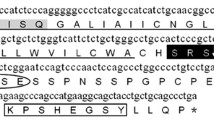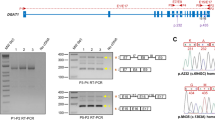Abstract
Context
In previous investigations, we have demonstrated the mutations in the signal peptide of porcine GH gene were associated with the body size.
Methods
In this study, the fusion gene expression vectors which consisted of eight signal peptide mutants of GH gene and EGFP gene were constructed according to three missense mutations (p.Val9Ala, p.Gln22Arg and p.Asp25Gly), and they were transfected into the GH3 cell line.
Results
The inhibition levels of EGFP gene transcriptions with different signal peptide mutants were significantly different. Typically, the allelic variants carrying Val in codon nine showed higher protein synthesis (P < 0.05), and the allelic variants carrying neutral Gln in codon 22 and Gly in codon 25 showed higher secretion proportion (P < 0.05) compared with the other groups as assessed by western blotting. In silico RNA folding prediction indicated that the mutations gave rise to different RNA secondary structures, suggesting that they might affect translation and protein synthesis.
Conclusion
We conclude that the missense mutations within the signal sequence influence the expression and the secretion of the protein. To the best of our knowledge, this is the first report addressing the functional consequences of the mutations in the signal peptide of porcine GH gene.







Similar content being viewed by others
References
Vize PD, Michalska AE, Ashman R, Lloyd B, Stone BA, Quinn P, Wells JR, Seamark RF (1988) Introduction of a porcine growth hormone fusion gene into transgenic pigs promotes growth. J Cell Sci 90(Pt 2):295–300
Yerle M, Mansais Y, Thomsen PD, Gellin J (1993) Location of the porcine homone gene to chromosome 12p1.2–p1.5. Anim Genet 24:129–131
Cheng WTK, Lee CH, Hung CM, Chang ITJ, Chen CM (2000) Growth hormone gene polymorphisms and growth performance traits in Duroc, Landrace and Tao-Yuan pigs. Theriogenology 54:1225–1237
Ho KKY, Hoffman DM (1993) Aging and growth hormone. Horm Res 40:80–86
Lincoln DT, Sinowatz F, El-Hifnawi E, Hughes RL, Waters M (1995) Evidence of a direct role for growth hormone (GH) in mammary gland proliferation and actation. Anat Histol Embryol 24:107–115
Sumantran VN, Tsai ML, Schwartz J (1992) Growth hormone induces c-fos and c-jun expression in cells with varying requirements for differentiation. Endocrinology 130:2016–2024
Henderson IR, Navarro-Garcia F, Desvaux M, Fernandez RC, Ala’Aldeen D (2004) Type V protein secretion pathway: the autotransporter story. Microbiol Mol Biol Rev 68:692–744
Duffaud G, Inouye M (1988) Signal peptidases recognize a structural feature at the cleavage site of secretory proteins. J Biol Chem 263:10224–10228
Hall MN, Gabay J, Schwartz M (1983) Evidence for a coupling of synthesis and export of an outer membrane protein in Escherichia coli. EMBO J 2:15–19
Mohren S, Weiskirchen R (2009) Non-synonymous gene polymorphisms in the secretory signal peptide of human TGF-β1 affect cellular synthesis but not secretion of TGF-β1. Biochem Biophys Res Commun 379:1015–1020
Mencarelli M, Zulian A, Cancello R, Alberti L, Gilardini L, Di Blasio AM, Invitti C (2012) A novel missense mutation in the signal peptide of the human POMC gene: a possible additional link between early-onset type 2 diabetes and obesity. Eur J Hum Genet 20:1290–1294
Schwartz M, Roa M, Debarbouille M (1981) Mutations that affect lamB gene expression at a posttranscriptional level. Proc Natl Acad Sci USA 78:2937–2941
Vize PD, Wells JRE (1987) Isolation and characterization of the porcine growth hormone gene. Gene 55:339–344
Seeburg PH, Sias S, Adelman J et al (1983) Efficient bacterial expression of bovine and porcine growth hormones. DNA 2:37–45
Zuker M (2003) Mfold web server for nucleic acid folding and hybridization prediction. Nucleic Acid Res 31:3406–3415
Livak KJ, Schmittgen TD (2001) Analysis of relative gene expression data using real-time quantitative PCR and the 2−ΔΔCT method. Methods 25(4):402–408
Rona RJ, Tanner JM (1977) Aetiology of idiopathic growth hormone deficiency in England and Wales. Arch Dis Child 52:197–208
Besson A, Salemi S, Deladoey J, Vuissoz JM, Eble A, Bidlingmaier M, Burgi S, Honegger U, Fluck C, Mullis PE (2005) Short stature caused by a biologically inactive mutant growth hormone (GH-C53S). J Clin Endocrinol Metab 90:2493–2499
von Heijne G (1986) J Mol Biol 192:287–290
Vlasuk GP, Inouye S, Inouye M (1984) J Bioi Chem 259:6195–6200
Kadonaga JT, Pluckthun A, Knowles JR (1985) J Biotechnol Chem 260:16192–16199
Acknowledgments
This work was supported by the National Natural Science Foundation of China (31101781, 31072102) and the Programs Foundation of Ministry of Education of China (20110061110081).
Author information
Authors and Affiliations
Corresponding author
Additional information
Yunyun Cheng and Songcai Liu have contributed equally to this study.
Rights and permissions
About this article
Cite this article
Cheng, Y., Liu, S., Lu, C. et al. Missense mutations in the signal peptide of the porcine GH gene affect cellular synthesis and secretion. Pituitary 19, 362–369 (2016). https://doi.org/10.1007/s11102-016-0713-6
Published:
Issue Date:
DOI: https://doi.org/10.1007/s11102-016-0713-6




